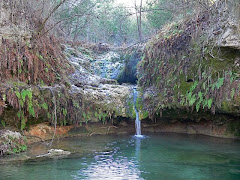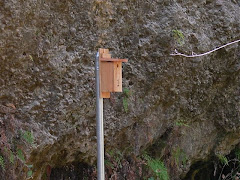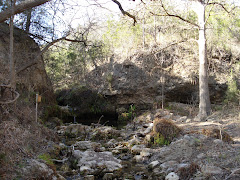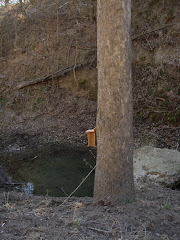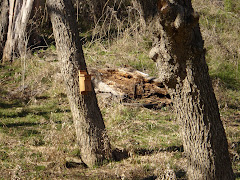Today myself and a neighbor took a leisurely trek to the Pedernales Falls State Park Bird Blind. In addition, I visited one of my nest box study sites, Hackenburg Creek. Just before turning into the Bird Blind we saw about 10 Feral Pigs rooting around along side the road plus a young fawn prancing around the roadside in play. Behind the bird blind along the walkway I heard the Bell's Vireo. Today was the first time I saw Tufted Titmice as well as the usual Black-crested Titmice. I wonder if juvenile Black-crested Titmice do not always have the black crest. There were more than a dozen Northern Cardinals in family groups eating sunflower seeds as well as the abundant House Finch. One of the juvenile Cardinals appears to have white feathers coming in on its head.
We spent several hours picnicking down at the confluence of Hackenburg Creek and the Pedernales River. There I watched closeup a male Green Kingfisher perch above me. Another individual flew by very quickly, like a bullet. I believe there are at least two pair of Green Kingfishers nesting along the river in the park. A pair of Summer Tanagers later perched above making a burry contact call for over 20 minutes in the big Bald Cypress tree. Turkey Vultures came down to drink from the rivers edge as did two White-tailed Deer.
I see no breeding bird activity taking place at the end of July in the middle of this hot Texas summer. Bird Blind volunteers reported less than half an inch of rain this past week from the recent Dolly Hurricane. Water levels on the Pedernales River remain low.
Prothonotary Warbler Occurrence In Texas
Central Texas draws the western line for the Prothonotary Warbler range. This species occupies much of eastern North America up to the southern boarder of Ontario Canada.
Prothonotarys' nest in natural cavities but also readily use nest boxes located on or near water. Flooded swamps represent ideal habitat but they will also nest along rivers or small bodies of water.
In May 2007 I saw a brightly colored male Prothonotary Warbler at Pedernales Falls State Park bird blind. After some research I learned male birds have been seen building nests in neighboring counties to Blanco County. Further research revealed a pair of Prothonotary Warblers successfully nested at Heard Wildlife Sanctuary in McKinney, Texas.
In December 2007 I decided to undertake a nest box study at the park. January through February 2008 I hiked the entire Pedernales River and tributaries within park boundaries, in an effort to choose the best sites. Habitat selection proved a challenge do to high flood levels along the river.
Five sights were eventually selected where two nest boxes each were placed. Most boxes were attached to trees however two were attached to metal poles. These boxes were monitored from March through June 2008 on a weekly basis. A Breeding Bird Study was conducted at each nestbox location in 2008 and will be continued in 2009.
Prothonotarys' nest in natural cavities but also readily use nest boxes located on or near water. Flooded swamps represent ideal habitat but they will also nest along rivers or small bodies of water.
In May 2007 I saw a brightly colored male Prothonotary Warbler at Pedernales Falls State Park bird blind. After some research I learned male birds have been seen building nests in neighboring counties to Blanco County. Further research revealed a pair of Prothonotary Warblers successfully nested at Heard Wildlife Sanctuary in McKinney, Texas.
In December 2007 I decided to undertake a nest box study at the park. January through February 2008 I hiked the entire Pedernales River and tributaries within park boundaries, in an effort to choose the best sites. Habitat selection proved a challenge do to high flood levels along the river.
Five sights were eventually selected where two nest boxes each were placed. Most boxes were attached to trees however two were attached to metal poles. These boxes were monitored from March through June 2008 on a weekly basis. A Breeding Bird Study was conducted at each nestbox location in 2008 and will be continued in 2009.
Sunday, July 27, 2008
Saturday, July 19, 2008
July Full Moon Birding
 On the drive into the park I saw perched two Common Ravens silhouetted against the early morning sky and I heard a Rufous-Crowned Sparrow and a Common Nighthawk singing/calling. A Jack Rabbit greeted me at the Primitive Campground parking lot.
On the drive into the park I saw perched two Common Ravens silhouetted against the early morning sky and I heard a Rufous-Crowned Sparrow and a Common Nighthawk singing/calling. A Jack Rabbit greeted me at the Primitive Campground parking lot.I arrived too late for a "Full Moon" bikeride but I managed to survey Tobacco Creek and East Park Boundary before the heat intensified. There was a noticable absence of songsters today especially during my bikeride along four miles of trail. In fact, there were more contact calls in the woods than anything else. New observations included a Chimney Swift and Cliff Swallows flying along the Pedernales River. This was the first time I did not hear any juvenile Red-shouldered Hawks squawking.
I finished out the morning at the bird blind where there were numerous Northern Cardinals and House Finches. A single Lark Sparrow along with female and juvenile Black-chinned Hummingbirds and Painted Buntings were also seen.
Water levels in the river are the lowest I have seen this year. The photo is of the only grassy part of the Wolf Mountain Trail that I ride near the east park boundary. Bird watching at the park appears to be done until Fall Migration begins.
Saturday, July 5, 2008
Final Bird Survey of the Year
 Rufous-crowned Sparrows were out in force this morning. I heard them singing before sunrise along with Common Nighthawks and Chuck-will's Widows from the Park Office (sunrise photo). A Rufous-crowned Sparrow continues to claim territory above Twin Falls.
Rufous-crowned Sparrows were out in force this morning. I heard them singing before sunrise along with Common Nighthawks and Chuck-will's Widows from the Park Office (sunrise photo). A Rufous-crowned Sparrow continues to claim territory above Twin Falls.I still have a Louisiana Waterthrush on territory along Twin Falls Creek and the nesting Blue Grosbeaks now have fledged young. The other nest I was following is the Acadian Flycatcher nest #2 at Tobacco Creek Seep. There is one nestling which both parents are feeding. I believe this young will be fledged within the week. I also saw one Acad ian Flycatcher fledgling from nest #1, along with an adult in the Tobacco Creek drainage.
ian Flycatcher fledgling from nest #1, along with an adult in the Tobacco Creek drainage.
 ian Flycatcher fledgling from nest #1, along with an adult in the Tobacco Creek drainage.
ian Flycatcher fledgling from nest #1, along with an adult in the Tobacco Creek drainage. At nest box #4 early in the morning I watched a Skunk rooting around and finally retire for the day in its den at the lower right base of this Live Oak tree root (photo). Directly after the skunk observation, I heard rustling in the grasses downhill. Two Armadillos were running around the  hillside playing. I thought for a moment I was contending with wild pigs.
hillside playing. I thought for a moment I was contending with wild pigs.
 hillside playing. I thought for a moment I was contending with wild pigs.
hillside playing. I thought for a moment I was contending with wild pigs. Throughout the rest of the year I will continue to mountain bike and bird watch at Pedernales Falls State Park. However, I may only be visiting once or twice a month. Stay tuned as I will post any wildlife encounters.
The plant photo is Caster Bean, cultivated in Texas for its oil and as an ornimental. The plant is native to Ethiopia and all parts of the plant are poisoness. It is common along Twin Falls Creek. It grows near the water and can reach 5' tall. It has a cockle bur-like seed.
Subscribe to:
Posts (Atom)

